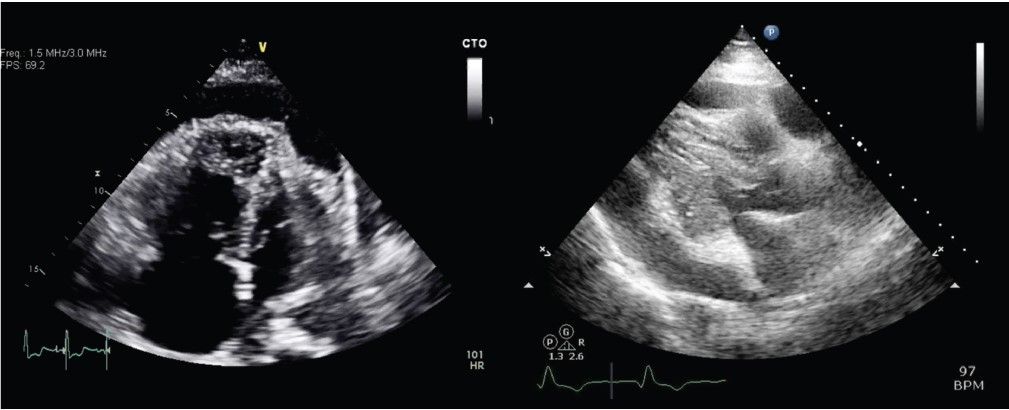
Cover image

Cardiac tamponade after pulmonary endarterectomy: mind the left side…
Lior Bibas1, Moza Al-Kalbani1, Marc de Perrot2, and Ghislaine Douflé1,3*
1Interdepartmental Division of Critical Care Medicine, University of Toronto, Toronto General Hospital, University Health Network, 200 Elizabeth Street, Toronto, Ontario M5G 2C4, Canada; 2Division of Thoracic Surgery, Toronto General Hospital, University Health Network, 200 Elizabeth Street, Toronto, Ontario M5G 2C4, Canada; and 3Department of Anesthesia, Toronto General Hospital, University Health Network, 200 Elizabeth Street, Toronto, Ontario M5G 2C4, Canada
*Corresponding author. Tel: 11 416 340 4645, Email: [email protected]
Two of our patients presented cardiac tamponade post-surgical pulmonary endarterectomy for chronic thromboembolic pulmonary hypertension (CTEPH). Both patients were therapeutically anticoagulated and presented with refractory shock on post-operative Day 4 (Patient A) and Day 10 (Patient B), respectively. Echocardiograms did not demonstrate classical right-sided chamber collapse albeit demonstrated moderate to large pericardial effusion with frank diastolic collapse of the left ventricle and impeded filling. Both patients received a therapeutic pericardiocentesis; Patient A underwent thoracotomy for surgical exploration and pericardial evacuation, whereas Patient B underwent a bedside ultrasound-guided pericardiocentesis. Pericardial drainage led to marked haemodynamic improvement.
Pericardial tamponade after pulmonary endarterectomy is a rare but life-threatening surgical complication. Patients with CTEPH are usually anticoagulated early in their post-operative course. Presence of right ventricular hypertrophy may protect the right ventricle from increased intrapericardial pressures, which explains why both our patients exhibited left ventricular collapse preceding right chamber collapse in the context of a new, large circumferential pericardial effusion.
It is important to keep a high index of suspicion for cardiac tamponade in haemodynamically unstable patients after pulmonary endarterectomy, which may appear days or weeks after surgery. While ultrasound remains an important tool in the evaluation and management of post-operative pericardial effusion, cardiac tamponade remains a clinical diagnosis, as classic echocardiographic signs may be absent (especially when mechanically ventilated). Furthermore, patients with chronic pulmonary hypertension and right ventricular hypertrophy, present additional challenge as left-sided chamber collapse may occur first.
Panel 1 (left: patient A): apical four-chamber view showing a large pericardial effusion with diastolic collapse of the apical left ventricular wall. Panel 2 (right: patient B): parasternal long-axis view demonstrating a large pericardial effusion with diastolic collapse of the mid-infero-lateral left ventricular wall.
Supplementary material is available at European Heart Journal online.









